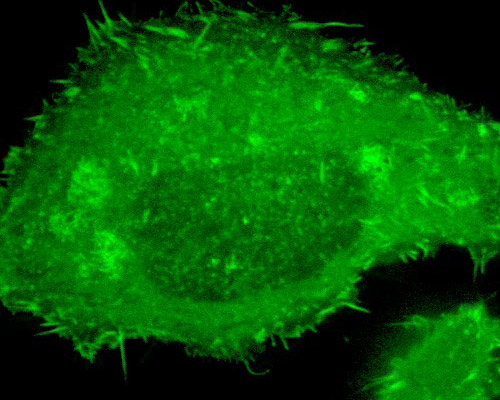Human Cervix Adenocarcinoma Cells with mEmerald-Plastin

Human cervix adenocarcinoma cells (the HeLa line) possess epithelial adherent morphology. Their cellular products are keratin and lysophosphatidylcholine (lyso-PC), which induces AP-1 activity and c-jun N-terminal kinase activity (JNK1) by a protein kinase C-independent pathway. The cells are positive for keratin by immunoperoxidase staining. HeLa cells have been reported to contain human papilloma virus 18 (HPV-18) sequences.
The EGFP variant mEmerald was utilized to visualize plastin in the digital video sequence of HeLa CCL2 cells presented in this section. Plastins are a family of monomeric actin-binding proteins first identified in avian intestinal microvilli. Also known as fimbrins, plastins are importantly involved in cytoskeletal stabilization and organization, as well as cell migration and adhesion. The three isoforms of plastin found in humans that vary in their tissue distribution include L, T, and I plastin.
Named for the similarly colored gemstone, mEmerald is a green fluorescent protein that exhibits excitation and emission maxima at 487 nanometers and 509 nanometers. mEmerald is brighter and more photostable than its parent protein. The primary weakness of the fluorescent protein is that a fast photobleaching component can render mEmerald poorly suited for certain applications.



